1993 CHEVROLET CAVALIER service
[x] Cancel search: servicePage 102 of 308
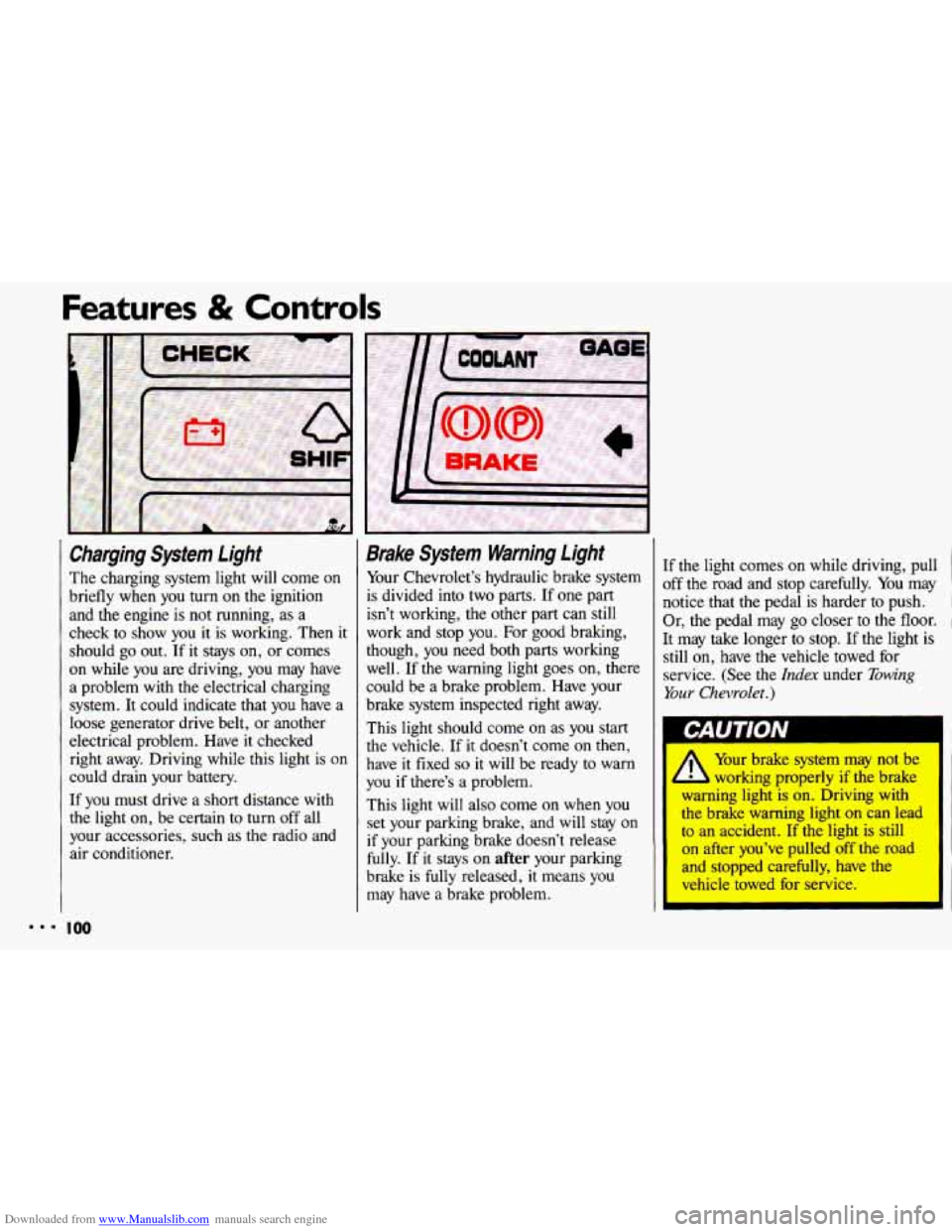
Downloaded from www.Manualslib.com manuals search engine Features & Controls
Charging System Light
The charging system light will come on
briefly when
you turn on the ignition
and the engine is not running, as a
check to show you it is working. Then it
should go out. If it stays on, or comes
on while you are driving, you may have
a problem with the electrical charging
system.
It could indicate that you have a
loose generator drive belt, or another
electrical problem. Have
it checked
right away. Driving while this light is on
could drain your battery.
If you must drive a short distance with
the light on, be certain to turn off all
your accessories, such as the radio and
air conditioner.
Brake Sysfem Warning Light
Your Chevrolet’s hydraulic brake system
is divided into two parts. If one part
isn’t working, the other part can still
work and stop you. For good braking,
though, you need both parts working
well. If the warning light goes on, there
could be a brake problem. Have your
brake system inspected right away.
This light should come on as you start
the vehicle. If it doesn’t come on then,
have
it fixed so it will be ready to warn
you if there’s
a problem.
This light will also come on when you
set your parking brake, and will stay
on
if your parking brake doesn’t release
fully. If it stays
on after your parking
brake is fully released,
it means you
may have
a brake problem. If
the light comes
on while driving, pull
off the road and stop carefully. You may
notice that the pedal is harder to push.
I
Or, the pedal may go closer to the floor. 1
It may take longer to stop. If the light is
still on, have the vehicle towed for
service. (See the
Index under Towing
Your Chevrolet.)
L-AU I IVN
I
/1 Your brake system may not be
L working properly if the brake
warning light is on. Driving with
the brake warning light
on can lead
to an accident. If the light is still
on after you’ve pulled off the road
and stopped carefully, have the
vehicle towed for service.
I
Page 103 of 308
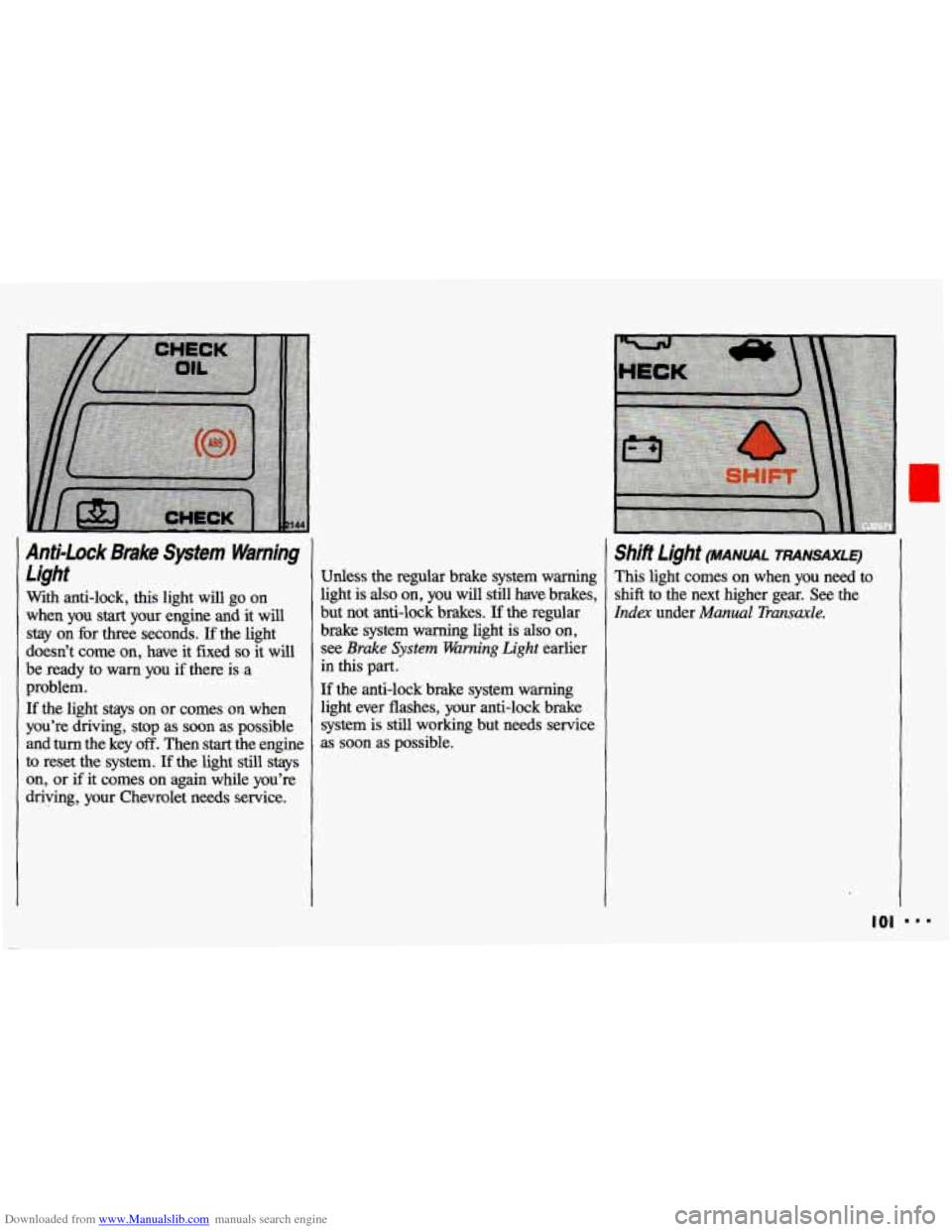
Downloaded from www.Manualslib.com manuals search engine Anti-Lock Brake System Warning
Light
With anti-lock, this light will go on
when you
start your engine and it will
stay on for three seconds.
If the light
doesn’t come on, have it fixed
so it will
be ready to warn you if there is a
problem.
If the light stays on or comes on when
you’re driving, stop as soon as possible
and turn the key
off. Then start the engine
to reset the system.
If the light still stays
on, or if it comes on again while you’re
driving, your Chevrolet
needs service.
Shift light (MANUAL TRANSAXLE)
Unless the regular brake system warning
brake system warning light is
also on,
Index under Manual Transale. but not anti-lock brakes. If the regular shift to the next higher gear. See
the
light is
also on, you will still have brakes, This
light comes on when you need to
in this part.
see Brake System Warning Light earlier
If the anti-lock brake system warning
light ever flashes, your anti-lock brake
system is still working but needs service
as soon as possible.
IO1
Page 104 of 308
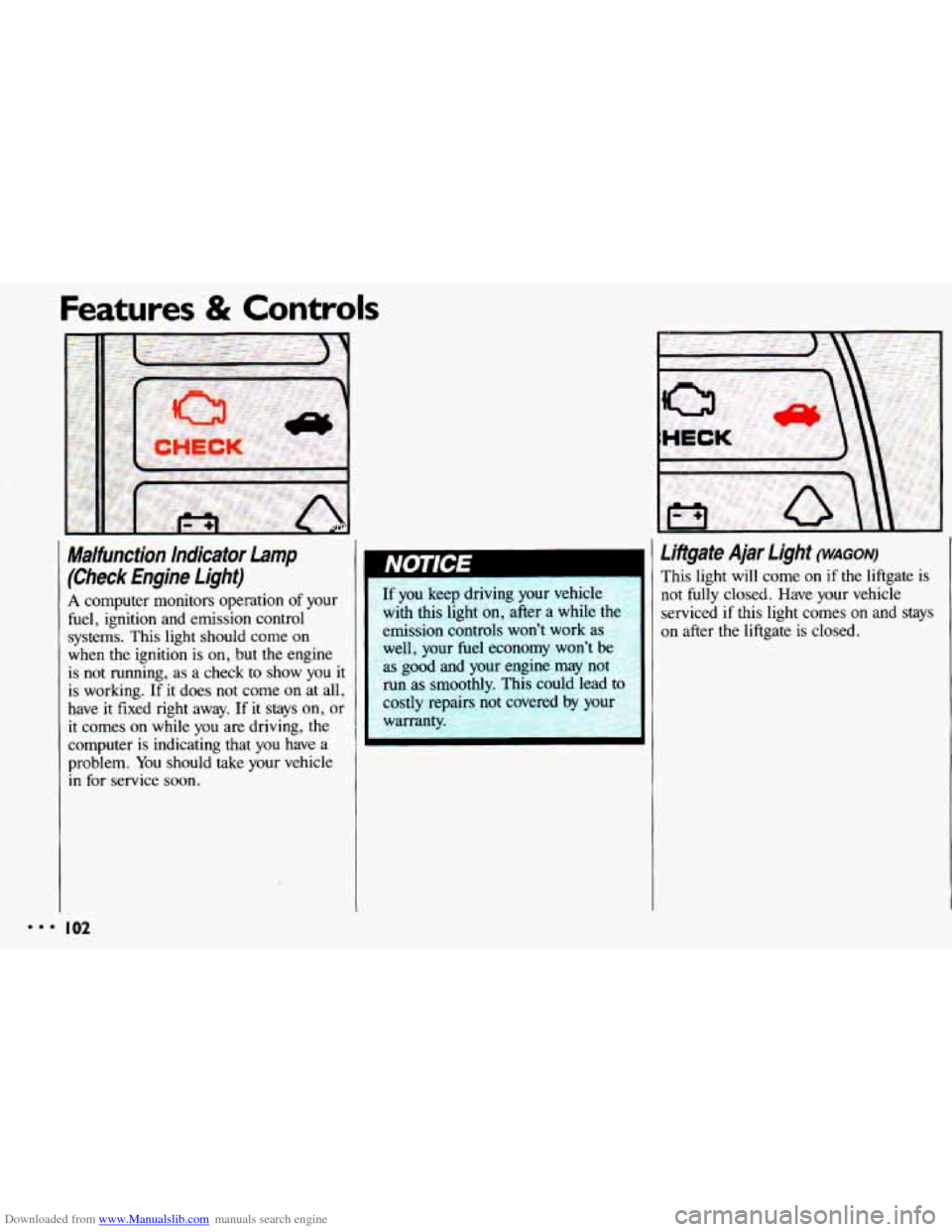
Downloaded from www.Manualslib.com manuals search engine ..I
Features & Controls
I
Malfunction Indicator Lamp
(Check Engine Lighf)
A computer monitors operation of your
fuel, ignition and emission control
systems. This light should come on
when
the ignition is on, but the engine
is not running, as a check to show you
it
is working. If it does not come on at all,
have
it fixed right away. If it stays on, or
it comes on while you are driving, the
computer is indicating that
you have a
problem.
You should take your vehicle
in for service soon.
I02
If you keep driving your vehicle
with this light on, after a while the
emission controls won’t work as
well, your fuel economy won’t be
as good and your engine may not
run as smoothly. This could lead to
costly repairs not rwered by your
warranty.
Liftgate Ajar Light (WAGON)
This light will come on if the liftgate is
not fully closed. Have your vehicle
serviced
if this light comes on and stays
on after the liftgate is closed.
Page 124 of 308
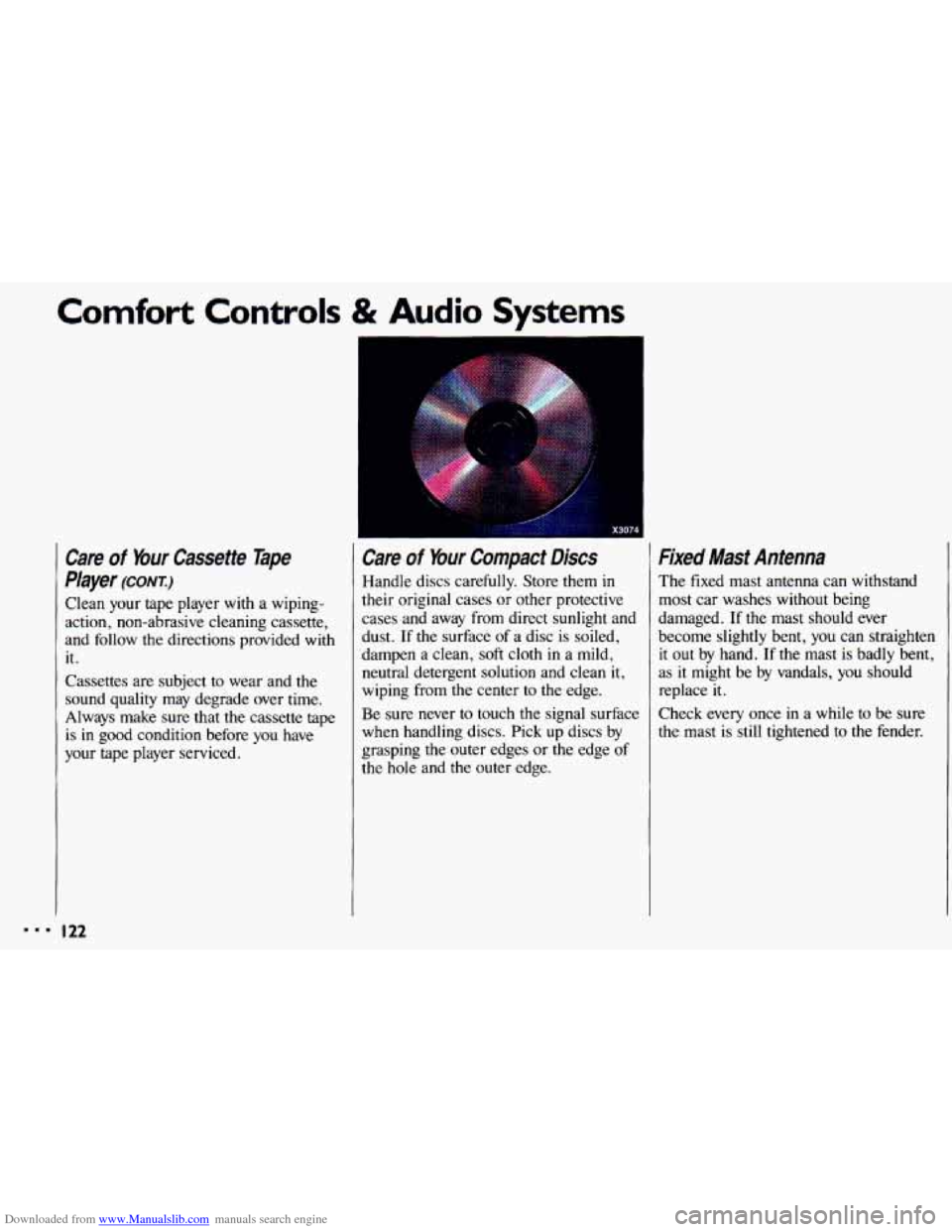
Downloaded from www.Manualslib.com manuals search engine Comfort Controls & Audio Systems
Care of Your Cassette Tape
Player
(CONT.)
Clean your tape player with a wiping-
action, non-abrasive cleaning cassette,
and follgw the directions provided with it.
Cassettes are subject to wear and the
sound quality may degrade over time.
Always make sure that the cassette tape is
in good condition before you have
your tape player serviced.
I22
X3074 m
Care of Your Compact Discs
Handle discs carefully. Store them in
their original cases or other protective
cases and away from direct sunlight and
dust. If the surface
of a disc is soiled,
dampen a clean,
soft cloth in a mild,
neutral detergent solution and clean
it,
wiping from the center to the edge.
Be sure never to touch the signal surface
when handling discs. Pick up discs by
grasping the outer edges or the edge
of
the hole and the outer edge.
Fixed Mast Antenna
The fixed mast antenna can withstand
most car washes without being
damaged.
If the mast should ever
become slightly bent, you can straighten it out by hand.
If the mast is badly bent,
as
it might be by vandals, you should
replace it.
Check every once in a while to be sure
the mast is still tightened
to the fender.
Page 126 of 308
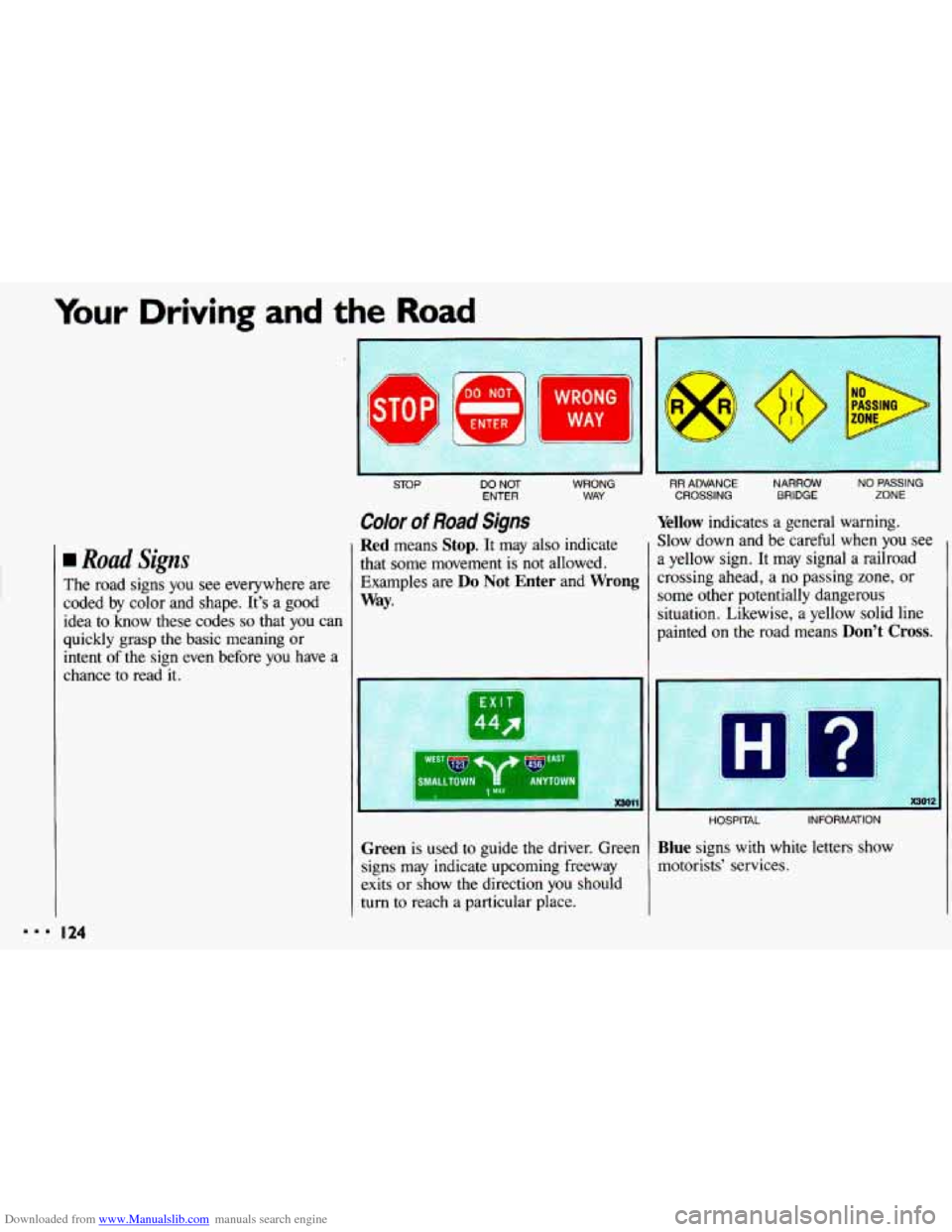
Downloaded from www.Manualslib.com manuals search engine Your Driving and the Road
Road Signs
The road signs you see everywhere are
coded
by color and shape. It's a good
idea to
know these codes so that you can
quickly grasp the basic meaning or
intent
of the sign even before you have a
chance to read it.
SrOP DO NOT WRONG ENTER WAY
;_.
Color of Road Signs
Red means Stop. It may also indicate
that some movement is
not allowed.
Examples are
Do Not Enter and Wrong
Way.
.... YTDU
Green is used to guide the driver. Green
signs may indicate upcoming freeway
exits
or show the direction you should
turn to reach a particular place.
RR ADVANCE NARROW NO PASSING
CROSSING BRIDGE ZONE
Yellow indicates a general warning.
Slow down and be carefbl when
you see
a yellow sign.
It may signal a railroad
crossing ahead, a no passing zone, or
some other potentially dangerous
situation. Likewise, a yellow solid
line
painted on the road means Don't Cross.
HOSPITAL INFORMATION
Bhe signs with white letters show
motorists' services.
... I24
Page 137 of 308
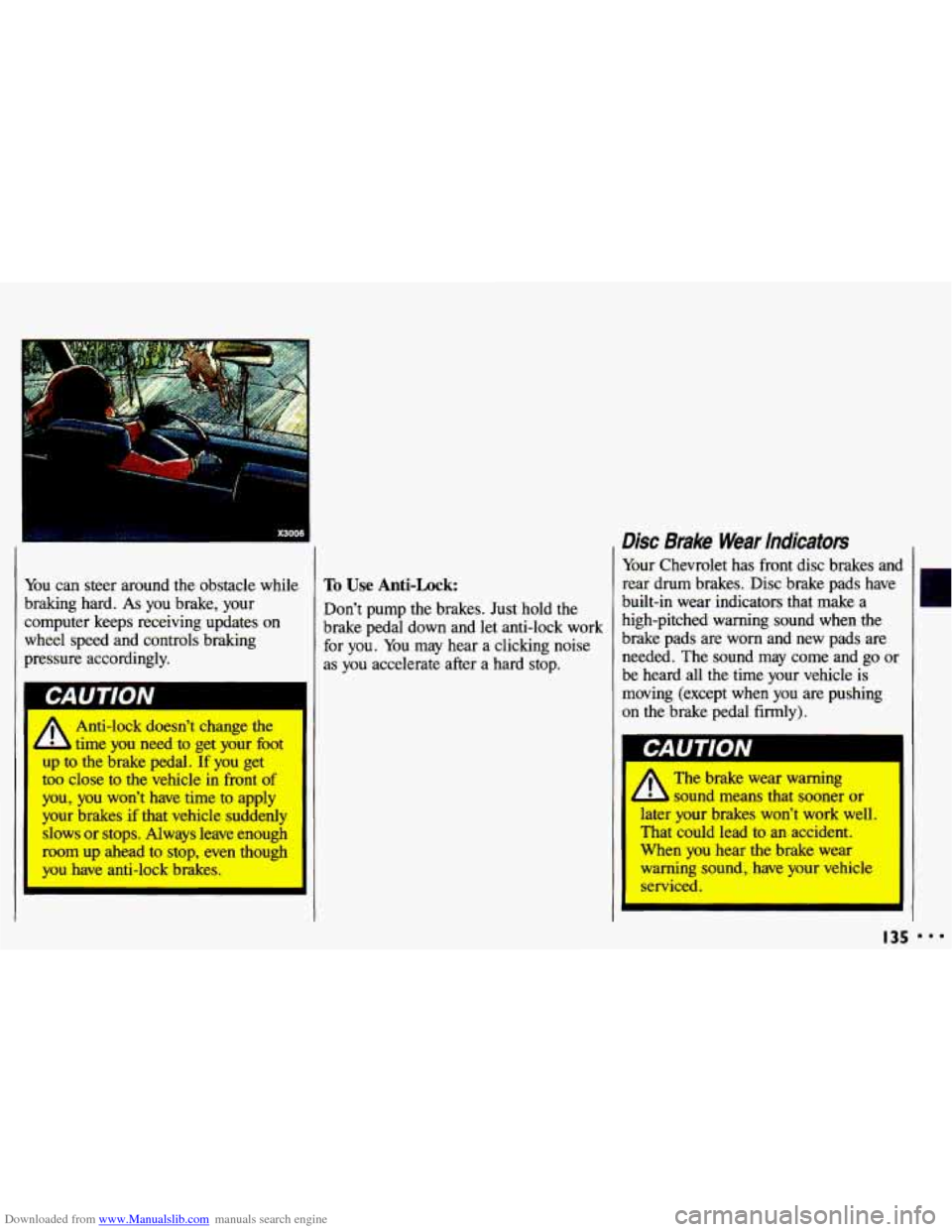
Downloaded from www.Manualslib.com manuals search engine b~
W
P’
I
I
ou can steer around the obstacle while
raking hard.
As you brake, your
lmputer keeps receiving updates
on
thee1 speed and controls braking
ressure accordingly.
A Anti-lock doesn’t change the
L time you need to get your ht
to the brake pedal. If you get
too close to the vehicle in front of
you, you won’t have time to apply
your brakes if that vehicle suddenly
slows or stops. Always leave enough
morn up ahead to stop, even though ’
YOU have anti-l~~k brakes.
To Use Anti-Lock:
Don’t pump the brakes. Just hold the
brake pedal down and let anti-lock work for
you. You may hear a clicking noise
as you accelerate after a hard stop.
Disc Brake Wear indicators
Your Chevrolet has front disc brakes and
rear drum brakes. Disc brake pads have
built-in wear indicators that make a
high-pitched warning sound when the
brake pads are worn and new pads are
needed. The sound may come and
go or
be heard all the time your vehicle is
moving (except when you are pushing
on the brake pedal firmly).
The brake wear warning
4 L sound means that sooner or
later your brakes won’t work well,
That could lead to an accident.
When you hear the brake wear
warning sound, have your vehicle
serviced.
bAUIIUN
c
I35
r
888
Page 146 of 308
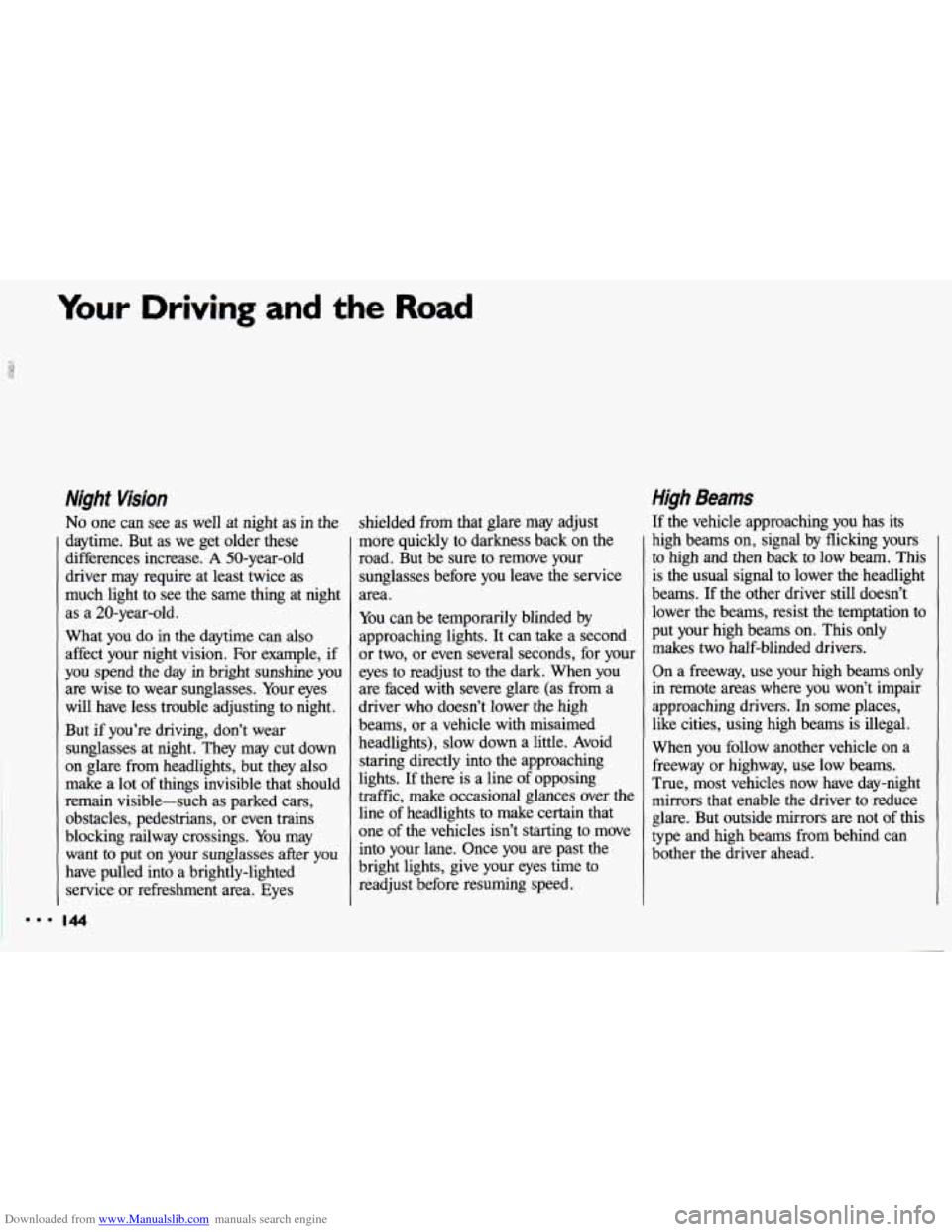
Downloaded from www.Manualslib.com manuals search engine Your Driving and the Road
‘I
Night Wsion
No one can see as well at night as in the
daytime. But as we get older these
differences increase. A SO-year-old
driver
may require at least twice as
much light to see the same thing at night
as a 20-year-old.
What you do in the daytime can
also
affect your night vision. For example, if
you spend the day in bright sunshine you
are wise to wear sunglasses. Your eyes
will have less trouble adjusting to night.
But if you’re driving, don’t wear
sunglasses at night. They may cut down
on glare from headlights, but they
also
make a lot of things invisible that should
remain visible-such as parked cars,
obstacles, pedestrians, or even trains
blocking railway crossings. You may
want to
put on your sunglasses after you
have pulled into a brightly-lighted
service or refreshment area. Eyes
I44
shielded from that glare may adjust
more quickly to darkness back on the
road. But be sure to remove your
sunglasses before you leave the service
area.
You can be temporarily blinded by
approaching lights. It can take a second
or two, or even several seconds, for your
eyes to readjust to the dark. When you
are faced with severe glare (as from a
driver who doesn’t lower the high
beams, or a vehicle with misaimed
headlights), slow down a little. Avoid
staring directly into the approaching
lights. If there is a line of opposing
traffic, make occasional glances over the line of headlights to make certain that
one
of the vehicles isn’t starting to move
into your lane. Once you are past the
bright lights, give your eyes time to readjust before resuming speed.
High Beams
If the vehicle approaching you has its
high beams on, signal by flicking yours
to high and then back to low beam. This is the usual signal to lower the headlight
beams.
If the other driver still doesn’t
lower the beams, resist the temptation to
put your high beams on.
This only
makes two half-blinded drivers.
On a freeway, use your high beams only
in remote areas where you won’t impair
approaching drivers.
In some places,
like cities, using high beams is illegal.
When you follow another vehicle on a
freeway or highway, use low beams.
True, most vehicles now have day-night
mirrors that enable the driver to reduce
glare. But outside mirrors are not of this
type and high beams from behind can
bother the driver ahead.
Page 154 of 308
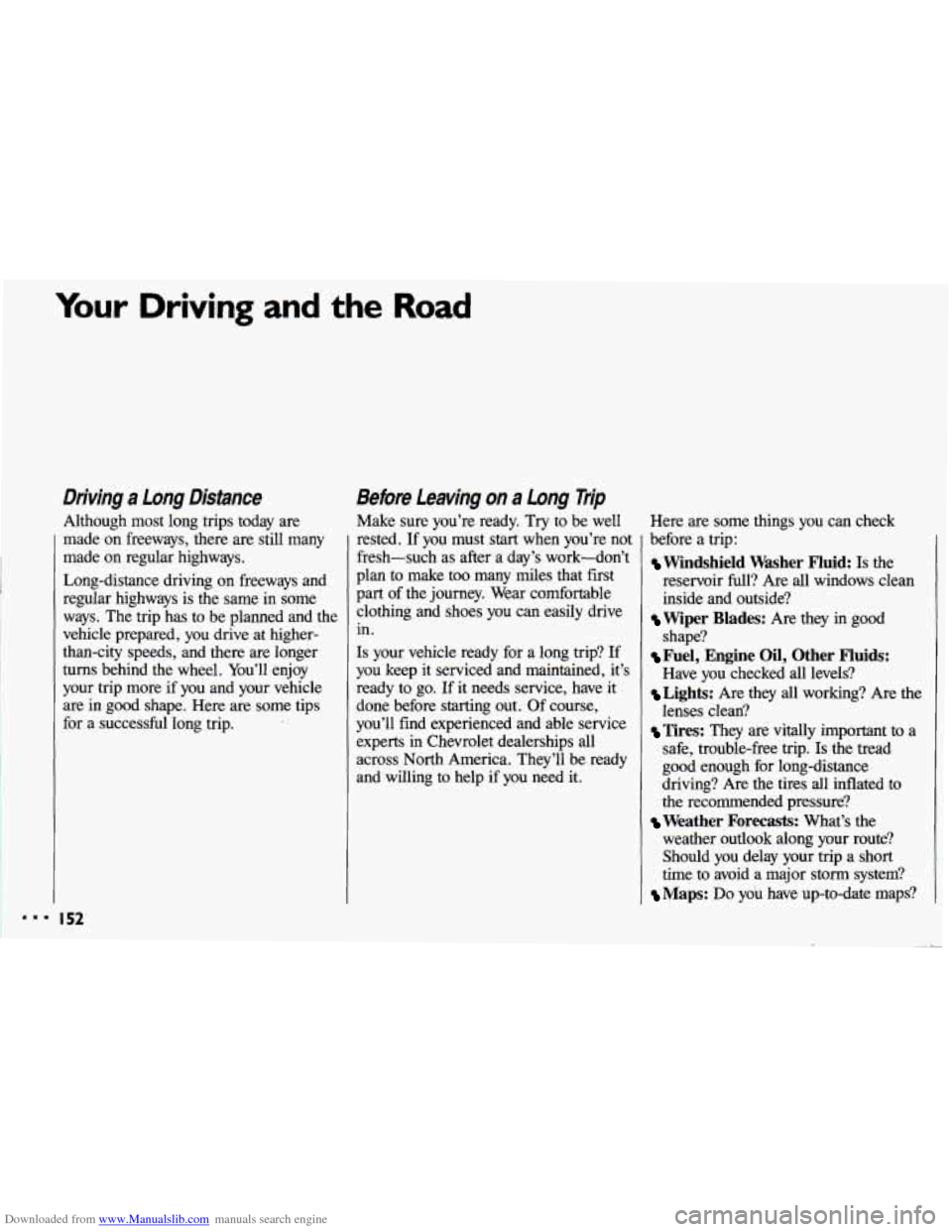
Downloaded from www.Manualslib.com manuals search engine Your Driving and the Road
Driving a Long Distance
Although most long trips today are
made on freeways, there are still many
made on regular highways.
Long-distance driving on freeways and
regular highways is the same in some
ways. The trip has to be planned and the
vehicle prepared, you drive at higher-
than-city speeds, and there are longer
turns behind the wheel. You’ll enjoy
your trip more
if you and your vehicle
are in good shape. Here are some tips
for a successful long trip.
Before Leaving on a Long Trip
Make sure you’re ready. Try to be well Here are some things you can check
rested. If you must start when you’re not
fresh-such as after a day’s work-don’t
plan to make too many miles that
first
part of the journey. Wear comfortable
clothing and shoes you can easily drive in.
Is your vehicle ready for a long trip? If
you keep it serviced and maintained, it’s
ready to
go. If it needs service, have it
done before starting out. Of course,
you’ll find experienced and able service experts
in Chevrolet dealerships all
across North America. They’ll be ready
and willing to help if you need it.
I’
before a trip:
Windshield Washer Fluid: Is the
reservoir full? Are all windows clean
inside and outside?
shape?
Have you checked all levels?
lenses clean? safe, trouble-free trip.
Is the tread
good enough for long-distance
driving? Are the tires all inflated to
the recommended pressure?
weather outlook along your route?
Should you delay your trip a short
time to avoid a major storm system?
Maps: Do you have up-to-date maps?
Wiper Blades: Are they in good
Fuel, Engine Oil, Other Fluids:
Lights: Are they all working? Are the
Tires: They are vitally important to a
Weather Forecasts: What’s the